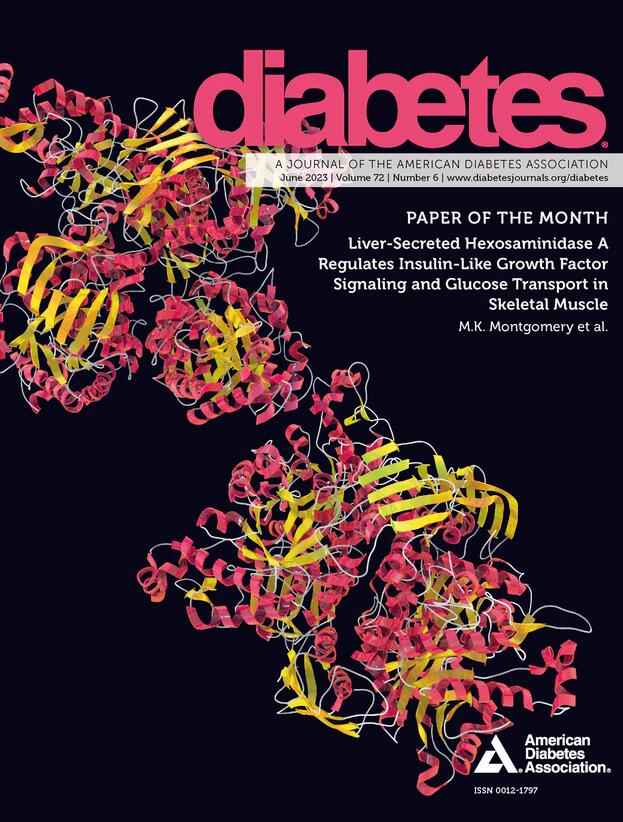Splanchnic and Leg Glucagon Metabolism in Healthy and Type 1 Diabetes: First in Human Study Using [13C9, 15N1]-Glucagon
IF 6.2
1区 医学
Q1 ENDOCRINOLOGY & METABOLISM
引用次数: 0
Abstract
Circulating glucagon concentrations differ between individuals with no diabetes (ND) and those with type 1 diabetes (T1D). We combined isotope dilution technique using stable tracers [6,22 13C9, 15N1]-glucagon and [6,14,19,22 13C9, 15N1]-glucagon with splanchnic and leg catheterization in participants with ND (n = 8; age 23.1 ± 2.9 years, BMI 26.6 ± 3.5 kg/m2, HbA1c 5.0 ± 0.2% [31 ± 2 mmol/mol]) and T1D (n = 6; 29.0 ± 8.8 years, BMI 26.3 ± 5.0 kg/m2, HbA1c 7.9 ± 0.8% [63 ± 8 mmol/mol]) in the overnight fasted state. After baseline period, exogenous glucagon was infused at rates designed to achieve plasma glucagon concentrations spanning the physiological ranges, to determine the effects of rising glucagon concentrations on splanchnic and leg glucagon balance. At baseline, splanchnic glucagon extraction (SGE) was similar (30.7 ± 2.7 vs. 29.1 ± 2.9%) but leg glucagon extraction (LGE) was lower (27.0 ± 4.2 vs. 40.6 ± 3.1%) in participants with T1D versus those with ND. However, with increasing plasma glucagon concentrations, while SGE remained unchanged within and between groups, LGE fell in participants with ND (41 vs. 31 vs. 24%) but did not change in those with T1D. Despite a numerically lower net splanchnic glucagon production in participants with T1D than in those with ND, no changes were observed with increasing glucagon concentrations within the physiological range in both groups. This is the first human study applying novel glucagon isotopes that describes regional glucagon metabolism in participants with ND and T1D. Our observations provide translational relevance for dual hormone closed loop systems and provide tools for probing the effects of GLP-1, dual, and triple receptor agonists on pancreatic α-cell functions. ARTICLE HIGHLIGHTS This study was conducted to assess splanchnic and leg glucagon metabolism in humans using stable glucagon isotopes. We wanted to evaluate whether splanchnic and leg glucagon metabolism differed between participants with no diabetes (ND) and those with type 1 diabetes (T1D) at glucagon concentrations spanning the physiological range. Whereas splanchnic glucagon extraction did not differ between participants with ND and those with T1D, leg glucagon extraction fell in those with ND but did not change in those with T1D as glucagon concentrations increased. Net splanchnic glucagon production did not change with exogenous glucagon infusion. Our study has implications for dual hormone closed loop control in T1D where glucagon is infused for prevention of hypoglycemia and for investigating the effects of emerging GLP-1, glucose-dependent insulinotropic polypeptide, and glucagon receptor agonists on endogenous glucagon secretion and clearance.健康和1型糖尿病患者内脏和腿部胰高血糖素代谢:首次使用[13C9, 15N1]-胰高血糖素进行人体研究
循环胰高血糖素浓度在非糖尿病患者(ND)和1型糖尿病患者(T1D)之间存在差异。我们将同位素稀释技术与稳定示踪剂[6,22 13C9, 15N1]-胰高血糖素和[6,14,19,22 13C9, 15N1]-胰高血糖素联合应用于ND患者的内脏和腿部导管置入术(n = 8;年龄23.1±2.9岁,BMI 26.6±3.5 kg/m2, HbA1c 5.0±0.2%[31±2 mmol/mol]), T1D (n = 6;空腹状态29.0±8.8岁,BMI 26.3±5.0 kg/m2, HbA1c 7.9±0.8%[63±8 mmol/mol])。基线期后,外源性胰高血糖素以设计的速度注入,使血浆胰高血糖素浓度跨越生理范围,以确定胰高血糖素浓度升高对内脏和腿部胰高血糖素平衡的影响。在基线时,T1D患者的内脏胰高血糖素提取量(SGE)相似(30.7±2.7 vs. 29.1±2.9%),但腿部胰高血糖素提取量(LGE)较低(27.0±4.2 vs. 40.6±3.1%)。然而,随着血浆胰高血糖素浓度的增加,虽然SGE在组内和组间保持不变,ND患者的LGE下降(41 vs. 31 vs. 24%),但T1D患者的LGE没有变化。尽管T1D患者的净内脏胰高血糖素生成量低于ND患者,但两组患者胰高血糖素浓度在生理范围内均未见变化。这是第一个应用新型胰高血糖素同位素描述ND和T1D参与者区域胰高血糖素代谢的人类研究。我们的观察结果为双激素闭环系统提供了翻译相关性,并为探索GLP-1、双受体和三重受体激动剂对胰腺α-细胞功能的影响提供了工具。本研究使用稳定的胰高血糖素同位素评估人体内脏和腿部胰高血糖素代谢。我们想要评估在胰高血糖素浓度跨越生理范围时,无糖尿病(ND)和1型糖尿病(T1D)参与者的内脏和腿部胰高血糖素代谢是否存在差异。ND患者和T1D患者的内脏胰高血糖素提取量没有差异,ND患者的腿部胰高血糖素提取量下降,但T1D患者的腿部胰高血糖素提取量没有随着胰高血糖素浓度的增加而变化。外源性胰高血糖素输注后,净内脏胰高血糖素产量没有改变。我们的研究对T1D患者的双激素闭环控制具有启示意义,在T1D患者中,输注胰高血糖素以预防低血糖,并研究新出现的GLP-1、葡萄糖依赖性胰岛素性多肽和胰高血糖素受体激动剂对内源性胰高血糖素分泌和清除的影响。
本文章由计算机程序翻译,如有差异,请以英文原文为准。
求助全文
约1分钟内获得全文
求助全文
来源期刊

Diabetes
医学-内分泌学与代谢
CiteScore
12.50
自引率
2.60%
发文量
1968
审稿时长
1 months
期刊介绍:
Diabetes is a scientific journal that publishes original research exploring the physiological and pathophysiological aspects of diabetes mellitus. We encourage submissions of manuscripts pertaining to laboratory, animal, or human research, covering a wide range of topics. Our primary focus is on investigative reports investigating various aspects such as the development and progression of diabetes, along with its associated complications. We also welcome studies delving into normal and pathological pancreatic islet function and intermediary metabolism, as well as exploring the mechanisms of drug and hormone action from a pharmacological perspective. Additionally, we encourage submissions that delve into the biochemical and molecular aspects of both normal and abnormal biological processes.
However, it is important to note that we do not publish studies relating to diabetes education or the application of accepted therapeutic and diagnostic approaches to patients with diabetes mellitus. Our aim is to provide a platform for research that contributes to advancing our understanding of the underlying mechanisms and processes of diabetes.
 求助内容:
求助内容: 应助结果提醒方式:
应助结果提醒方式:


